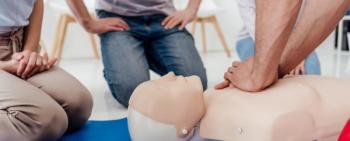
- Consultant for Pediatricians Vol 5 No 4
- Volume 5
- Issue 4
Photoclinic: Congenital Aplasia of the Depressor Anguli Oris Muscle
The mother of this 2-month-old boy was concerned about her son's facial asymmetry that was apparent only when he was crying. The right angle of the infant's mouth dropped substantially below the left angle of the mouth when he cried; it also deviated to the right (A). The moment the child stopped crying, his mouth became symmetric again (B).
A
B
The mother of this 2-month-old boy was concerned about her son's facial asymmetry that was apparent only when he was crying. The right angle of the infant's mouth dropped substantially below the left angle of the mouth when he cried; it also deviated to the right (A). The moment the child stopped crying, his mouth became symmetric again (B).
Linda S. Nield, MD, of West Virginia University, and Deepak M. Kamat, MD, PhD, of Wayne State University, diagnosed left-sided congenital aplasia of the depressor anguli oris muscle (CADAOM).
CADAOM occurs in approximately 0.3% to 0.7% of newborns.1,2 Complete absence of the muscle is rare, as revealed by sonographic studies,3 but absent or reduced numbers of motor unit potentials are not rare in patients who undergo electromyography.4
The condition is diagnosed clinically by observing the obvious physical finding. The child displays symmetric facial movements except in the oral region where the lower lip on one side does not depress while crying.
CADAOM can occur as an isolated anomaly, but patients with CADAOM have a higher risk of other malformations than the general population.2 Systems that may have associated abnormalities include cardiac, musculoskeletal (hemihypertrophy),5 genitourinary,2 otolaryngologic,5 and endocrine (hypothyroidism).6 Congenital heart disease with CADAOM (Cayler syndrome) seems to be transmitted in an autosomal dominant fashion,7 and CADAOM in association with 22q11 microdeletion has been reported.8
No treatment is required for this defect, but a thorough physical examination is warranted for all neonates with CADAOM to look for other malformations. (None were present in this baby.) Further testing, such as echocardiography or renal ultrasonography, should be pursued if warranted by abnormal physical examination findings.
References:
REFERENCES:
1.
Lahat E, Heyman E, Barkay A, Goldberg M. Asymmetric crying facies and associated congenital anomalies: prospective study and review of the literature.
J Child Neurol.
2000;15:808-810.
2.
Garzena E, Ventriglia A, Patanella GA, et al. Congenital malformations and asymmetric crying facies [in Italian].
Acta Biomed Ateneo Parmense.
2000;71 (suppl 1):507-509.
3.
Roedel R, Christen HJ, Laskawi R. Aplasia of the depressor anguli oris muscle: a rare cause of congenital lower lip palsy?
Neuropediatrics.
1998;29:215-219.
4.
Martinez Granero MA, Arguelles F, Roche Herrero MC, et al. Facial asymmetry with crying: a neurophysiological study and clinical account of this entity [in Spanish].
An Esp Pediatr.
1998;48:44-48.
5.
Caksen H, Patiroglu T, Ciftci A, et al. Asymmetric crying facies associated with hemihypertrophy: report of one case.
Acta Paediatr Taiwan.
2003;44:98-100.
6.
Kurtoglu S, Caksen H, Per H, et al. Asymmetric crying facies and congenital hypothyroidism: report of two patients.
J Pediatr Endocrinol Metab.
2001;14: 1177-1181.
7.
D'Addio AP, Taiti S, Vitarelli A. A case of the cardiofacial syndrome (Cayler's syndrome) [in Italian].
Minerva Pediatr
. 1993;45:189-192.
8.
Akcakus M, Ozkul Y, Gunes T, et al. Associated anomalies in asymmetric crying and 22q11 deletion. 2003;14:325-330.
Articles in this issue
over 19 years ago
Day-Old Boy With Respiratory Distress After Complicated Deliveryover 19 years ago
A 7-Year-Old Boy With Blistering Skinover 19 years ago
Guest Commentary: If I Have Herpes, Can I Still Have Children? . . .over 19 years ago
Neonatal Acne in a 3-Week-Old Boyover 19 years ago
Photoclinic: Inflamed Keratosis Pilarisover 19 years ago
Case in Point: A Young Girl With Cafe au Lait SpotsNewsletter
Access practical, evidence-based guidance to support better care for our youngest patients. Join our email list for the latest clinical updates.














